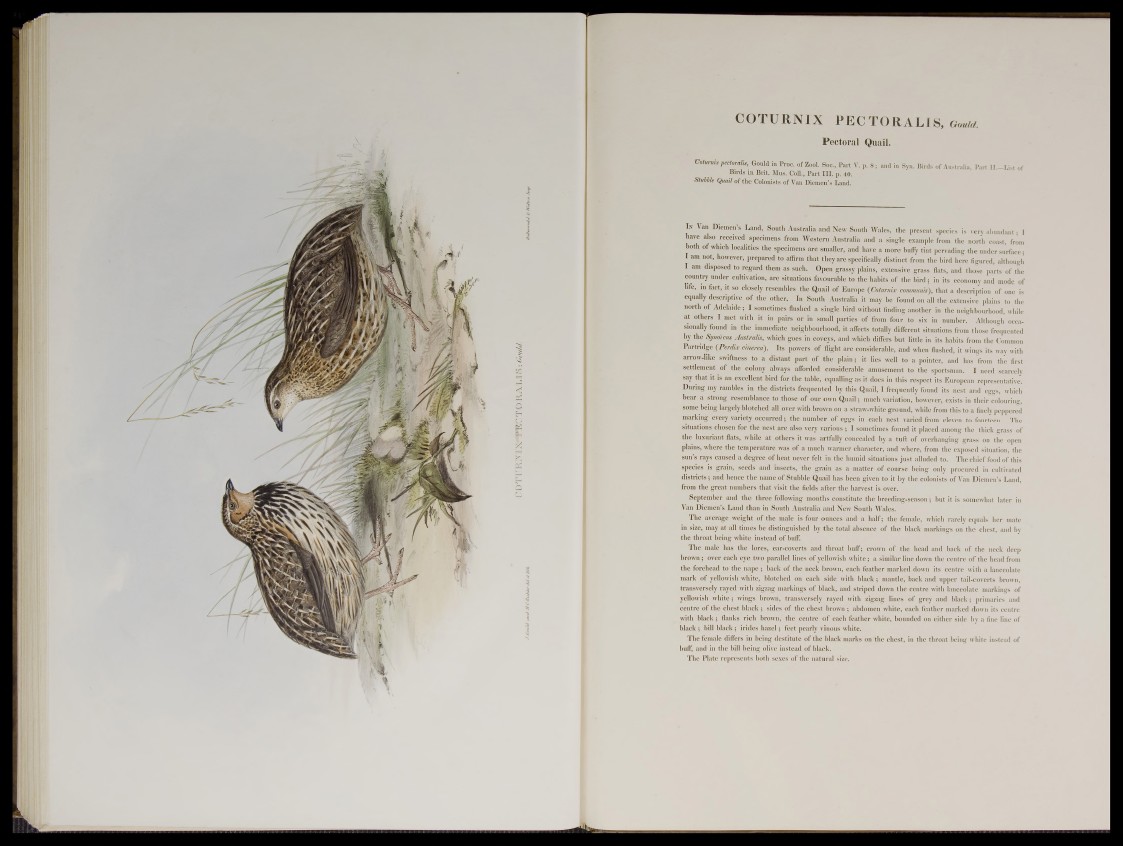
O0TURNIX PECTORALIS,
Pectoral Quail.
Votumuo pectnrriyt, Goffid ini-roc . t Zool l | § P a r t | p 8. and In Syn Birds of Australia, Part II.-L is to f
t ^ .B 'r i ^ ii ^ l iy yM n ^ S f l EartBBBi). 40. -
Stubble Quail Land •
the present species is very abundant ■ 1
'Pfiinnns Mom M W ^ ^ iw 'rd iT « r ..r .T smith < (ample*from, the north coast, from
, ’“ iiiis - ll«- 11 e srpaljer, .and' have.a more bufly tint pervading the under surface;
I am n o t ^ ^ y er; j,|gpared to affirm ^ a ^ e y j y 4 apecilic.illi d^ g b S ffffig b ird here figured, although
I an)''d,srPosep ^ ^ ^ d them as such. Open g r a s s y ^M a ’iextensive ‘grass flats, and those parts of the
country under cult vati n ir 1 1 t jps l^i jr'iJ l t vtl J i h i ^ i rii bird; in its economy and mode o f
■ jfe, _ in fact, it so cldsely .resembles the Quail of Europe ( Colurnise communis), that a description of one is
* e q u a lly -d e s c rip tiv e .p ^ (|^ o |^ g In South ;Australia;;i r :m a g |e found on alb the extensive plains to the 5®St|l Adelaide5 1 sometimes flushed a s i n g l e |^ t o i t j ^ ^ ^ # ? a n d t h (4 tl the neighbourhood, while
at others I met with - i ^ ^ j ^ i i k ^ ^ f e s t i a l l parties of from four to six in number. Although occasionally
found in the immediate neighbourhood, it affects' totally diff<|§u| situations from those frequented
I f th e Synoicus Australis,\ which-gqes in coveys, a ||g |h ic h d i ||r |: but little in, its habits from the Common
Partridge (Perdiw cinerea). Its powers of flight are considerable, and when flushed, it wings its way with
arrow-like swiftness to -a distant (part of the p l a k ; l g ^ from the first
settlement of the * g ||n y always afforded considerable amusement to the sportsman. I need scarcely
Say tliat ifc is an excellent bird for the table, equalling as at does in this respect its European representative,
f i r i n g my rambles in the d istric t feqgented-by thisYQ^ad|l^exiaently found its nest and eggs, which
near a strong resemblance to those of our own ^ uM ^ 1^u^ty|piatfon,' however, e x ^ ^ w l ^ r colouring,
some^being largely ^ |j |j i e d ‘all over w i t® ^ ^ ^ ^ ^ B a v ^ i i t ^ g r o u n d , while from i | | | | a finely peppered
marking every, variety occurred; the number of eggs in each nest varied from eleven to fourteen. The
situations chosen for theneSt are also very various 5 I sometimes found it placed among the thick grass of
the luxuriant flats, while'Strothers i t was a |^ ^ o n c h a l e d % -a tii^ of overhanging grass on the open
plains, wjferd the temperature was ©f a much warmer character, and where, fromgthe exposed situation, the
sun’s rays caused a degree of heat never felt in the humid situations just alluded to. The chief food of this
species is^ grain, seeds and insects, a matter of' c f u rk hSihg ; o | | ^
districts; and hence the name of S t l |$ |g ^ a i l h a s i ) e e ^ | e n / t ( ^ ^ the colonists of Van Diemen’s Land,
from the g r e a t^ ^ b e r s that visit the fields after the harvest is over.
September and the* three following months constitjite tlie breeding-season; but it is somewhat later in
Van Diemen’s Land than in South Australia and New South Wales. ‘
The average weight o f the male is four ounces and a half; the female, whichjrarely equals her mate
in size, may at all times be disringuished by the total absence of the black markings on the chest, and by
the throaf being" white instead of buff.
The male has the lores, ear-coverts and throat huff; crown of the head and back of the neck deep
brown; over each eye two parallel lines of yellowish white; a similar line down the centre of the head from
the forehead to the nape ; back of the neck brown, eacli feather marked down 'i,ts centre with a lanceolate
mark of yellowish white, blotched on each side; with black; mantle, back and upper tailrcoverts brown,
transversely rayed with zigzag markings of black, andktritfed dhwn the centre with lanceolate markings of
yellowish white ; wings brown, transversely rayed with zigzag lin e s,of grey and black; primaries and
centre of the chest black 5 sides, of the chest brown ; a p |b ^ e ^ p h f te ^ ^ p f e a th e r marked down its centre
with black ; flanks rich brown, the centre of each feather white:,'hphnHed on either side J>ya fine line of
black 5 bill black; irides hazel; fe#fhe,arly vinous white..
The female diffcrs;kjbe.i°g destitute oftheblaek marks orr’the chest, in the throat being ™vhite
instead of
buff, and in the?]M^being olive instead of black.
The Plate represents both sexes of the natural size.